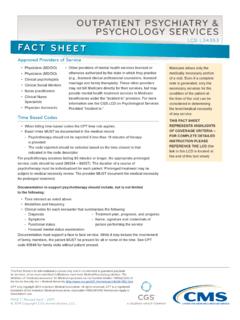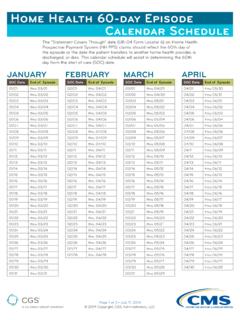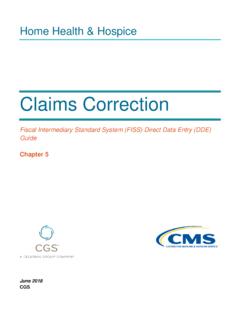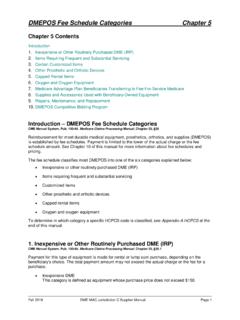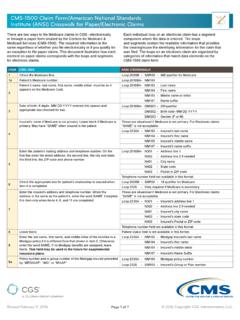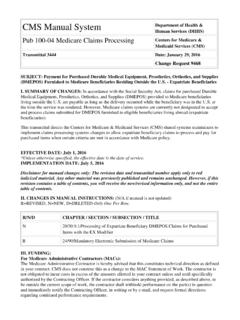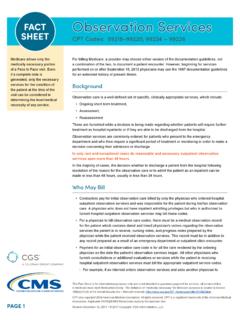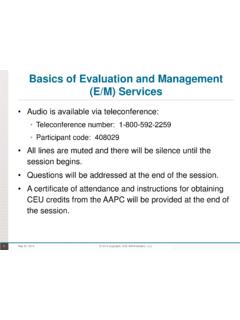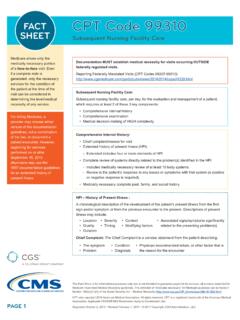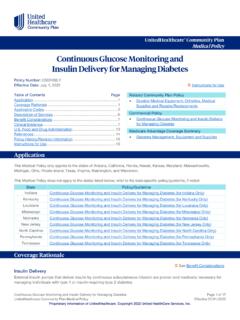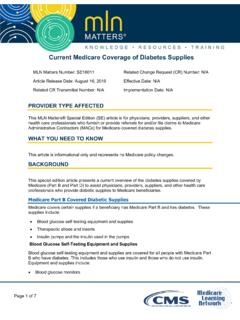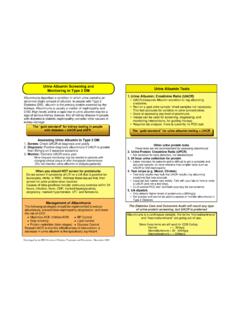Transcription of Coverage and Coding of Continuous Glucose Monitors
1 Coverage and Coding of Continuous Glucose MonitorsHello and welcome to another edition of Medicare Minute MD. I m Dr. Robert Hoover, medical director at CGS Administrators, the Jurisdiction C DME MAC. Today I m go-ing to talk about a recent decision by the Centers for Medicare and Medicaid Services or CMS, that changed the Medicare Program s Coverage of Continuous Glucose monitor sys-tems. This change was effective January 12, 2017. What is a Continuous Glucose monitor system? A typical CGM system has three compo-nents a sensor that is inserted under the skin and measures Glucose levels; some way to transmit that measurement; and, some way to display those measurements. With most CGM systems on the market today, the sensor and transmitter are replaced on a regular basis. I mentioned January 12 and that s a key date here.
2 To understand what CMS did you have to go back about a month before the January 12 Ruling to an action taken by the Food and Drug Administration in December 2016. And to understand the FDA action, you need to understand two terms Adjunctive and non-adjunctive as they relate to CGM means supplementary or in addition to . Non-adjunctive means that it can stand alone. So when the FDA talked about CGM systems prior to December 2016, they were all considered by the FDA to be adjunctive. So you might ask Adjunctive to what? Prior to December 2016, the FDA did not consider a CGM system as accurate enough to be the primary device for making therapy decisions about Glucose levels. You had to make those decisions with a standard home Glucose monitor . Several manufacturers of CGM systems have approached the FDA about changing their position on adjunctive use.
3 In December, the FDA did that for one CGM system - the Length: 15:43 Date Recorded: G5 Mobile CGM system. It was the first CGM system that the FDA allowed to be marketed as a non-adjunctive CGM system, meaning it could serve as the primary de-vice to make therapy decisions. In other words, the FDA did not require a standard blood Glucose monitor to make decisions about blood Glucose level treatment. That decision triggered action at CMS to reconsider the benefit category for CGM system. Because of the adjunctive designation for CGM systems by the FDA, CMS did not cover CGM systems as durable medical equipment. They were considered precautionary or backup equipment because they were not the primary device used to make therapeutic decisions about diabetes treatment. With the change by the FDA for the Dexcom system, CMS had to reconsider January 12, 2017 CMS issued Ruling 1682R.
4 CMS Rulings are official pronounce-ments of the Agency by the Administrator and are binding on all contactors and Admin-istrative Law Judges. Ruling 1682R made a benefit category decision about CGM systems. On your screen now you ll see the Conclusion from the CMS ruling. I ve highlighted the important points which I ll summarize: There s a lot of words here but I think the easiest way to remember this is that CGMs are covered for beneficiaries who have diabetes and require: 1. Frequent testing2. Frequent dosing of insulin3. Frequent adjustment of diet and insulinThe CMS Ruling used two terms to classify CGM systems: therapeutic CGM and Non- therapeutic CGM. The CMS Ruling declared that therapeu -tic CGM systems are covered under the DME benefit because they re used to make thera-peutic decisions about blood Glucose treatment.
5 And as of the date of this video, there is only one CGM system that meets this CMS benefit category definition the Dexcom G5 Mobile CGM system. Now let s dig a little deeper into this CMS decision and what make this DME. Recall I opened this segment talking about the components of a CGM system the sensor, the transmitter and the display device, sometimes called a receiver. The CMS Ruling deter-mined that the Dexcom G5 receiver was considered the durable component meeting the defintion of DME. With that designation as DME, the disposable sensor and transmitter get covered as supplies to the covered DME. Now let s shift gears to claim submission. How do claims for CGM systems get billed to the DME MAC? First, you have to determine if the device that you re billing is a Dexcom G5 Mobile CGM system. Dexcom has several different models and it s only the G5 ver-sion that qualifies as DME.
6 And it s only the Dexcom G5 that, at the time of this video production, qualifies as DME. This means that devices from other manufacturers DO NOT meet the definition of DME. Turning to billing now, I ll first discuss the billing of everything BUT the G5 system first because that s the easiest to discuss. CMS established HCPCS codes several years ago to describe the components of a CGM system. On your screen now you ll see those are the codes that have been used to bill CGM systems to Medicare and should continue to be used to bill for Non- therapeutic CGM systems. They are non-covered for Medicare because non-therpeutic CGM systems are not considered DME. What about billing for the Dexcom G5 system? The Ruling outlines therapeutic CGM as comprising two elements: (1) a DME component and, (2) an all-inclusive supply allow-ance.
7 The DME component for the Dexcom G5 Mobile CGM system is the receiver. The receiver must be billed using HCPCS code E1399 - DURABLE MEDICAL EQUIP-MENT, MISCELLANEOUSWhen billing this code, suppliers must enter Dexcom G5 Receiver in the narrative field of the supply allowance for supplies used with the Dexcom G5 Mobile CGM System en-compasses all items necessary for the use of the device and includes, but is not limited to: CGM sensor, CGM transmitter, home blood Glucose monitor and related BGM supplies (test strips, lancets, lancing device, and calibration solutions) and all batteries. The supply allowance must be billed using HCPCS code A9999 DURABLE MEDICAL EQUIPMENT, MISCELLANEOUS SUPPLYC laims for A9999 must be billed as one (1) unit of service per month. When billing this code, suppliers must enter Supplies used with Dexcom G5 Receiver in the narrative field on the claim.
8 You might ask What is this supply allowance? Recall that the Ruling declared that a CGM replaces the function of a standard home blood Glucose monitor for beneficiaries with diabetes who have to monitor their blood Glucose frequently in order to make thera-peutic decisions about diet and insulin therapy. With the designation of the Dexcom G5 receiver as DME, there are supplies that are covered for the effective use of that DME. So CMS created a supply allowance, a monthly fee that s paid to the supplier for all supplies necessary for the use of the DME. It is not a set number of supplies. Like with the enteral nutrition supply allowance, the supply allowance for a CGM pays for everything needed for the CGM to function. So the sensors, transmitter, Glucose monitor and supplies that are needed for the calibration of the CGM, batteries, etcetera.
9 Anything that s needed. And with the supply allowance, you must not bill separately for anything related to the function of the CGM system. If you do, the claim lines for those items will be denied as unbundling. A couple of other important points before we move on to Coverage . First, in today s tech-nology-driven world, lots of folks use smart devices to monitor and track their health. Medicare does not pay for these types of technology. So for CGM systems, this has two important implications: First, Smart devices like tablet computers, laptops and smartphones are non-covered by Medicare because they do not meet the definition of DME. That is because they re not primarily and customarily used for a medical purpose, one of the tests for DME. If a sup-pliers chooses to bill Medicare for a beneficiary-owned smart device, it is billed using the non-covered HCPCS code A9270.
10 Second, Medicare only covers items consided to be DME. And when the DME is covered, the supplies are covered. So Coverage of the CGM system supply allowance is limited to those therapeutic CGM systems where the beneficiary ONLY uses a receiver classified as DME to display Glucose data. If a beneficiary uses a non-DME device (smart phone, tab-let, etc.) as the display device, either separately or in combination with a receiver classified as DME, the supply allowance is non-covered by Medicare. This is an important point so I ll repeat it. If a beneficiary uses a smart device to display their CGM data, Medicare will not pay for the supplies. It doesn t matter if they re using the receiver classified as DME in addition to the smart device. Use a smart device in any manner and the supplies are let s move on to Coverage .
